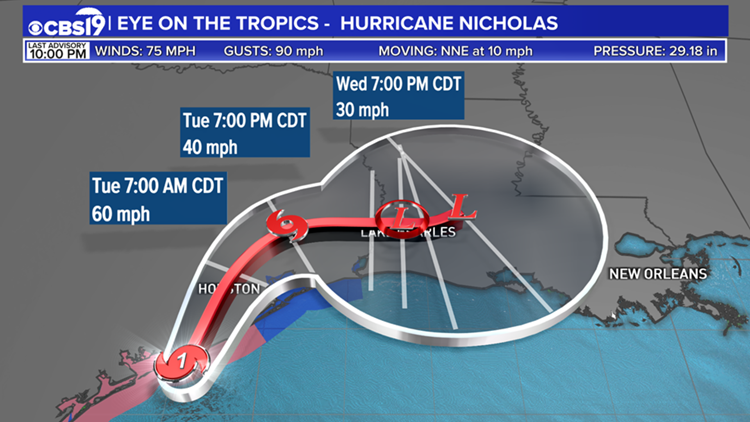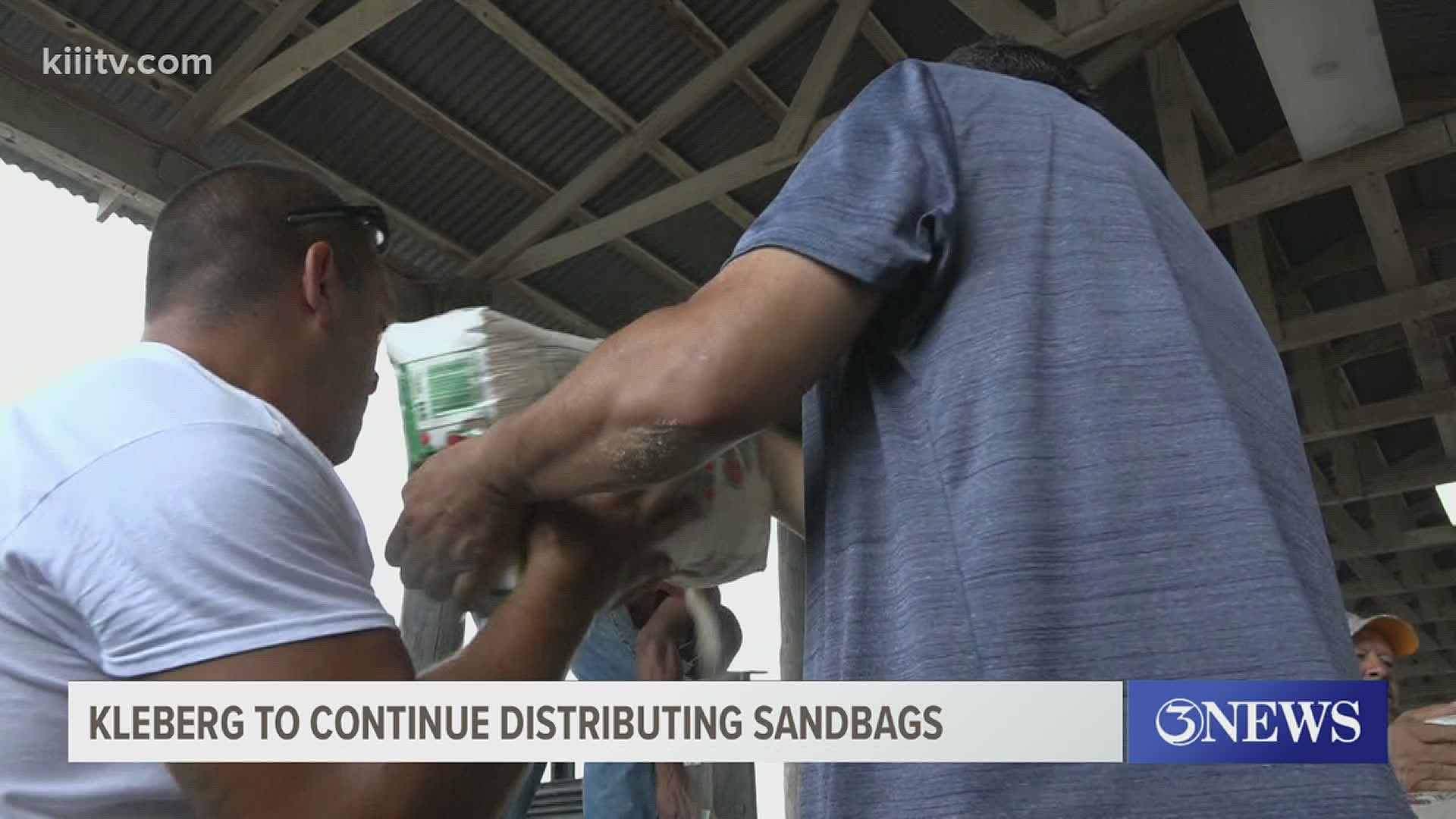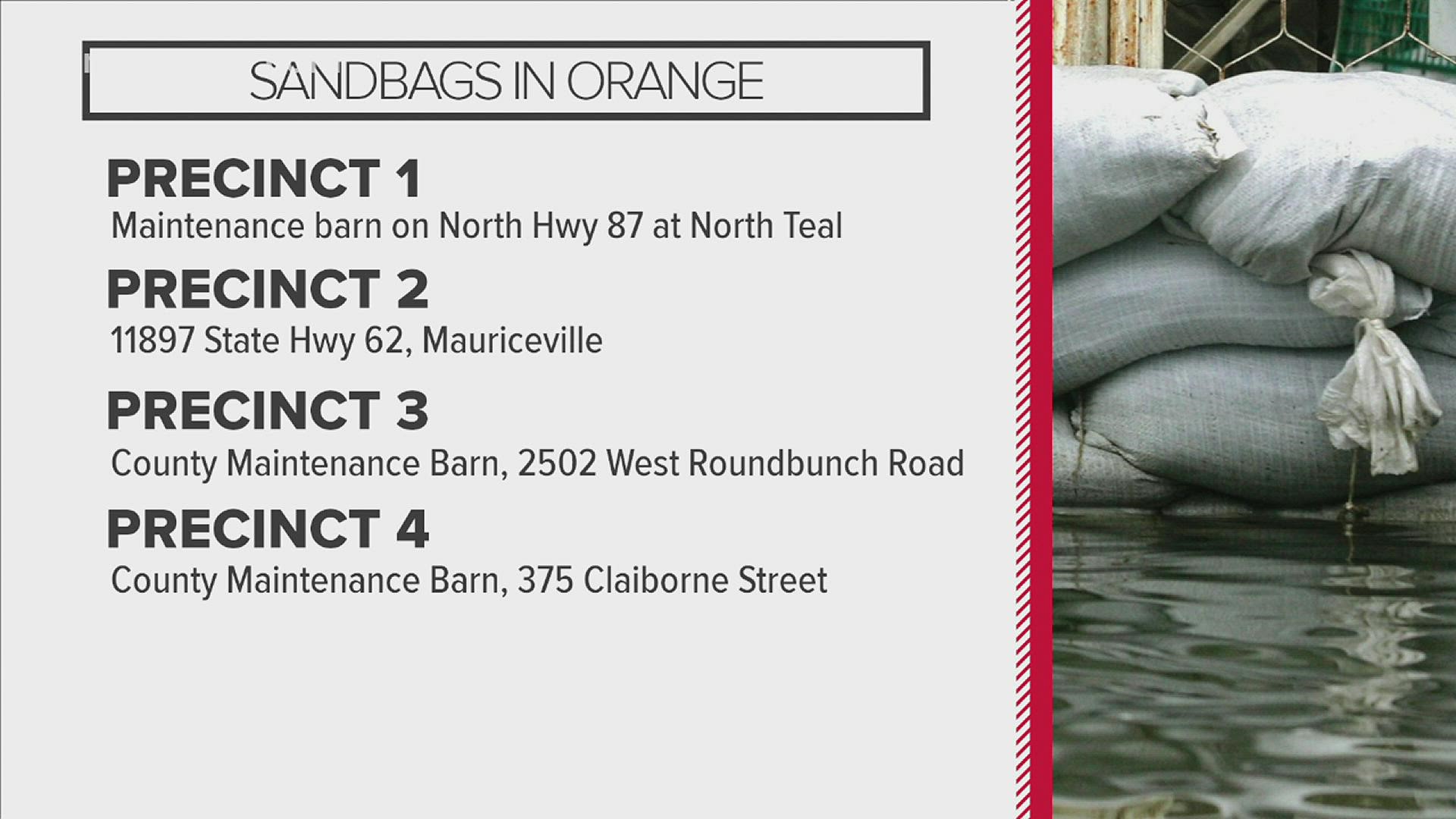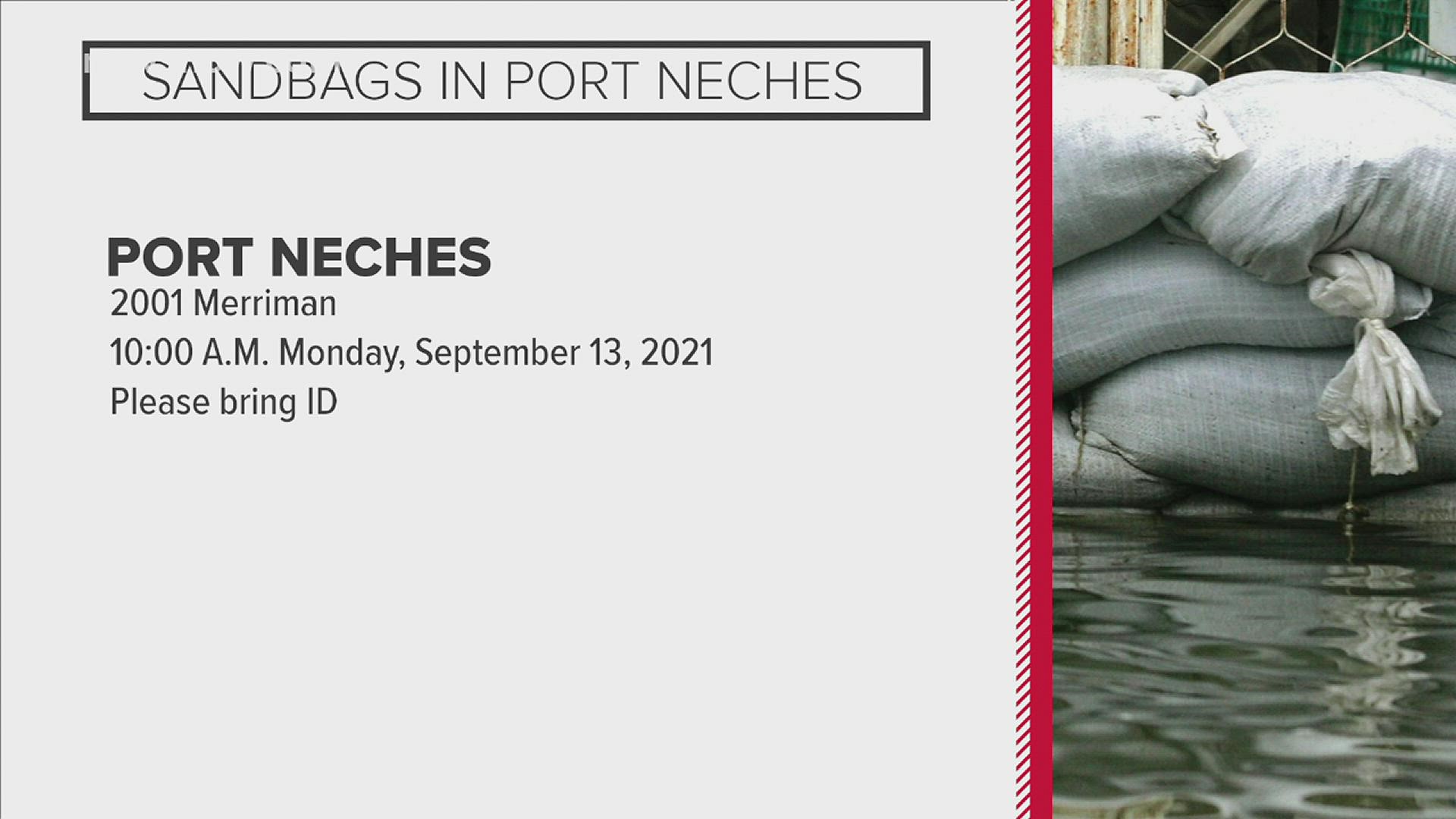SMITH COUNTY, Texas — The National Weather Service is alerting the East Texas area of a hazardous weather outlook due to Tropical Storm Nicholas.
Tropical Storm Nicholas, which was briefly upgraded to a hurricane before being downgraded again, made landfall along the Texas coastline Monday evening.
"Given the forecast track, heavy rainfall and possible flash flooding will be possible across portions of Deep East Texas and North Central Louisiana into tomorrow (Wednesday)," the NWS outlook said. "In addition, some weak and brief tornadoes may also be possible as is the case with any inland tropical system. Beyond Wednesday, showers and thunderstorms should be limited to mainly isolated afternoon activity during peak heating hours with no organized hazardous weather expected through this weekend."
As of 7 a.m. on Tuesday, Tropical Storm Nicholas' maximum wind speed has hit 60 miles per hour and it is moving north-northwest at eight miles per hour. The pace is similar to that of Hurricane Harvey in 2017 when the storm nearly stalled over parts of the Texas coast for days leading to epic rainfall totals.
"Heavy rainfall will impact areas from the upper coast of Texas, across Louisiana, southern Mississippi and far southern Alabama through the middle of the week," an NWS bulletin said. "There is a danger of life-threatening storm surge inundation along the coast of Texas from Sargent to Sabine Pass. Residents in these areas should follow any advice given by local officials."
While we do not expect those same rain totals with Tropical Storm Nicholas, some areas along the coast, southeast Texas and the Piney Woods could see up to 12 inches of rain.
Depending on the later storm track and intensity, this threat could also expand farther north to include more of the region up to the Interstate 20 corridor. In addition, some weak and short-lived tornadoes may also be possible; as is the case with any inland tropical system.
BE PREPARED
For a list of areas across East Texas that are prone to flooding, click here.
The following areas are giving out sandbags ahead of the possible severe rains that could lead to flooding:
Corpus Christi
- 3 p.m. - 6 p.m., Monday, Sept. 13 - 7402 Gulf Breeze Blvd.
- 3 p.m. - 6 p.m., Monday, Sept. 13 - 149 Zahn Rd.
Kleberg County
- FEMA dome behind HM King High School; 12 p.m.
Nederland
- Doombos Park - 2301 Avenue H
Orange County
- Pct. 1 - Maintenance barn on North Hwy. 87 at North Teal
- Pct. 2 - 11897 SH 62 in Mauriceville
- Pct. 3 - 2502 W. Roundbunch Rd.
- Pct. 4 - 375 Claiborne St.
Port Arthur
- Port Arthur Downtown Pavilion - 500 Procter St.
- Port Arthur Bob Bowers Civic Center - 3501 Culture Center Dr.
Port Neches
- City Service Center - 2001 Merriman St.; 10 a.m.
WHAT TO DO BEFORE A FLOOD
- Assess your risk for flooding. Do you live in a flood plain, in a low-lying area, or along the coast? Are there creeks and streams nearby that fill up when it rains? Are there low-lying areas near or around your home’s perimeter?
- If your risks are high, consider getting flood insurance. Most homeowners insurance policies do not cover damage from rising water.
- You may be able to reduce your risks by improving drainage near or around your home. Install drains or dig ditches to help divert water before it has a chance to rise.
- In some cases, sandbags can prevent floodwaters from entering your home. Purchase sandbags if you may need them, and be sure to fill them up ahead of time.
- When the threat of flooding is high, evacuate early. Don’t wait until it’s already flooded. If you have time, shut off the electricity before you go.
- Create your Disaster Supply Kit and keep it in an easily accessible place.
WHAT TO DO DURING A FLOOD
- Keep your Disaster Supply Kit handy so you can grab it and go in case you must evacuate suddenly.
- Don’t underestimate the power of floodwaters. They can move swiftly, often faster than they appear. They are very dangerous. A car will float in only a few inches of swiftly moving water.
- Never allow children to play near floodwaters.
- Adults are also at risk. As little as six inches of moving water can knock an adult off their feet.
- If you become stranded by floodwaters and must escape, wear a life jacket. In some situations, it may be safer to climb onto a rooftop or into a tree and wait for rescue.
- Never drive into flooded roadways. Water can look like it’s only a few inches deep when it’s actually several feet deep. All it takes is one foot of water to make a car or SUV float.
- Moving floodwaters can sweep away your car in a matter of seconds. If you see water on the road, turn around and don’t drown.
WHAT TO DO AFTER A FLOOD
Wait for local emergency management officials to give the all-clear before returning home.
When it’s safe to go home, take the following precautions:
- Do not enter your home if the electricity may still be on.
- Beware of displaced wildlife, such as snakes and bats. Do not handle them.
- Wear sturdy shoes, long pants, long sleeves, and gloves when cleaning up.
- Follow safety recommendations when using chain saws and power tools.
- Help prevent mold by disinfecting household items with a bleach solution.
POWER OUTAGES
For a list of power outages in your area, click here.
In the event of a power outage you'll want to make sure everything is accessible as possible.
Power out means lights out. You'll want to move your flashlights, lanterns or candles to a spot that easily accessible, so you're not fumbling around the dark.
Double check that your flashlight has batteries and is functional. It's also smart to buy extra batteries. It's the same with candles and lanterns, make sure you have lighters or matches handy or any necessary fluids.
Be sure to turn candles and lantern off before bed, and never leave candles or lanterns unattended!
What's in the fridge? It's strongly advised to have only nonperishable foods or counter-safe (some vegetables, fruits, bread) in the home. But if there's an item you can't part with and must be kept cold, here's an idea: have a styrofoam or other portable cooler, a quick-response thermometer and bags of ice handy.
Plus, if the weather is hot and humid, that ice can be useful in keeping you cool.
Electric stoves are useless during a power outage, and using a generator to power an electric stove or microwave can be dangerous. Plus, they can take up a lot of power in a short amount of time.
Before the storm is your chance to prepare other options: mini folding camp stove with canned fuel, self-heating portable meals or portable butane stove.
Charcoal and propane grills, which must be used only outdoors with adequate space, are other good options.
How do I keep my phone and other devices charged? In the hours leading up to storm conditions that can cause flooding, you will want to minimalize your device usage and allow them to charge to 100%.
If you have portable chargers — great! Make sure those are fully charged as well. They'll definitely come in handy.
If you have a vehicle, and it's safe to be outside, charging your phone in the car is a great backup option. REMEMBER: Do not sit in a running vehicle in a closed garage or other closed space. You could get carbon monoxide poisoning.
BEWARE OF ELECTRICAL LINES
During a flood, it is important to shelter in place, or stay where it is dry and safe! If it is an emergency or your shelter is compromised, forcing you to leave your home, be extremely cautious.
Don't try to leave in stormy weather conditions or during dark or nighttime hours.
If you're on foot, beware of power lines and electrical wires — even if the area is experiencing a power outages. Also be aware that electrical currents can travel through water.
Rule: treat all downed powerlines as if they're energized.
CenterPoint Energy says you should stay at least 10 feet away from any downed power lines and objects it may be touching. Be especially mindful of downed power lines that could be hidden in flood waters.
GENERATOR SAFETY
Generators can be a great luxury during a power outage, but guidelines must be followed to ensure everyone's safety.
Upshur Rural Electric Cooperative Corporation has put together a list of tips to make sure you and others stay safe when a generator is in use.
KNOW YOUR GENERATOR
- Read all of the information on installation, safety and maintenance.
- Follow instructions regarding maintenance and testing.
When a generator is not properly installed, it can "backfeed" through the transformer and produce an output of 7,200 volts on the distribution line. As a result, a line crew working on the system would be put in danger.
ISOLATE YOUR GENERATOR
- Keep your generator away from the power lines.
- Connect appliances and other devices directly to the generator with the appropriate-sized cords.
If you connect it directly to your building's wiring, a transfer, double-throw switch is required to separate your generator from the your service provider's system.
TAKE CARE WHEN FUELING
Never try to refuel the unit while it is operating. Avoid spilling gasoline or other fuels on hot components.
PROVIDE ADEQUATE VENTILATION
- Give your generator adequate ventilation and air cooling to prevent overheating and the accumulation of toxic exhaust fumes.
- Do not install your generator in a basement or any closed area.
Exhaust gases contain carbon monoxide, which is an odorless, invisible, poisonous gas.
CBS19 will continue to update this article as more information is released from the National Weather Service.







